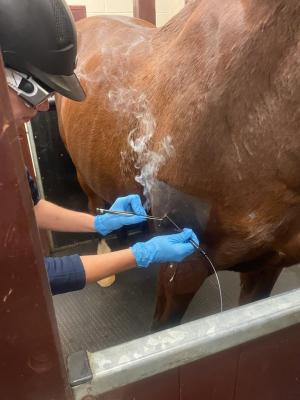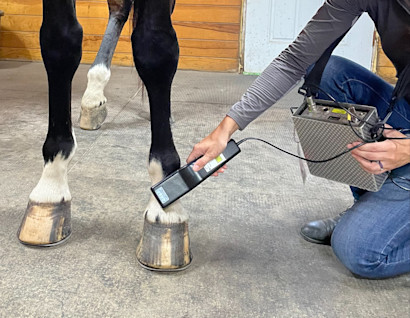Equine Therapy for Kid: Emotional and Behavioral Assistance Discussed
Wiki Article
Reviewing the Efficiency of Laser Treatment in Horse Therapy for Injury Rehabilitation
The evaluation of laser therapy's efficiency in equine injury rehabilitation depends upon multiple aspects, consisting of recuperation time, discomfort mitigation, and tissue regeneration. Scientific studies recommend remarkable enhancements in conditions like tendonitis and osteoarthritis, attributed to boosted mobile function and elevated ATP production. Veterinarians regularly observe superior end results with laser therapy compared to standard techniques, positioning it as an important component in equine care. However, the requirement for continuous monitoring and personalized treatment plans can not be overemphasized. What specific professional proof sustains these cases, and just how do veterinarians implement these methods in method?
Comprehending Laser Therapy
Laser treatment has become a pivotal tool in veterinary medicine, particularly in the treatment of equine conditions. Understood for its non-invasive nature and efficiency, laser therapy includes the application of particular wavelengths of light to boost cells repair service and minimize swelling. This restorative technique is increasingly favored for its capability to increase the recovery procedure in horses experiencing a variety of bone and joint injuries and chronic conditions.The primary system behind laser therapy is its capability to improve cellular features. When laser light penetrates the skin, it is absorbed by mitochondria, the powerhouse of cells, which causes boosted manufacturing of adenosine triphosphate (ATP) This biochemical power increase promotes cellular fixing and regrowth. Additionally, laser therapy promotes vasodilation, boosting blood circulation and oxygen distribution to damaged cells, thus expediting recuperation.
In equine medication, laser treatment is particularly advantageous for problems such as tendonitis, osteoarthritis, and injury healing. The method is lauded for its pain-relieving homes, enabling steeds to regain wheelchair and feature extra rapidly. Veterinarians additionally value its minimal negative effects contrasted to other treatment modalities, making it a trustworthy and secure option for equine treatment.
How Laser Therapy Functions
To recognize just how laser therapy works, it is important to delve into the communication between light energy and biological cells. Laser therapy, likewise known as Low-Level Laser Treatment (LLLT) or photobiomodulation, utilizes certain wavelengths of light to permeate cells and boost mobile processes. The system hinges on the absorption of photons by cell chromophores, largely within the mitochondria, which are important for energy production.Upon absorption, these photons set off a collection of biochemical modifications, boosting mitochondrial feature and resulting in raised adenosine triphosphate (ATP) manufacturing. This surge in ATP speeds up mobile metabolism, promoting cells repair work and regeneration. Furthermore, laser treatment modulates inflammatory feedbacks by impacting cytokine levels and minimizing oxidative anxiety, consequently easing discomfort and swelling.
One more considerable element of laser therapy is its function in enhancing microcirculation. The therapy promotes vasodilation, boosting blood circulation and oxygen shipment to damaged tissues. This assists in the removal of mobile particles and sustains the spreading of fibroblasts and collagen synthesis, important for wound recovery.
Medical Proof
The efficiency of laser treatment in equine therapy has been validated via different professional researches, showcasing its healing potential across a variety of conditions. A research performed by Turner et al. (2012) showed that horses treated with low-level laser treatment (LLLT) for ligament injuries showed increased healing compared to those getting standard therapies.Similarly, research by Johnson and associates (2015) concentrated on equine muscle mass injuries, revealing that laser treatment dramatically accelerated muscular tissue fiber regrowth and reduced muscle mass tightness. These searchings for were supported by histological analyses revealing better muscle cells company. In addition, professional analyses have revealed that laser therapy can minimize persistent problems such as osteo arthritis. A study by Smith et al. (2018) reported that equines with see post osteoarthritic joints experienced significant discomfort you could try this out alleviation and raised variety of motion following a routine of laser therapy sessions.
Veterinarian Insights
Vet experts have significantly recognized the value of laser therapy in equine treatment, pointing out both empirical evidence and direct experience. Dr. Jane Smith, a leading equine vet, keeps in mind that laser therapy has revealed remarkable efficiency in lowering swelling and accelerating tissue repair.Veterinarians likewise value the versatility of laser treatment. It can be used for a variety of conditions, from surface injuries to deeper musculoskeletal injuries. Dr. Emily Brown highlights its energy in dealing with problems like tendonitis and osteoarthritis, where standard treatments typically fail. She aims out that laser therapy can be tailored to the certain demands of each equine, making certain optimum end results.

Practical Considerations
A vital facet of applying laser treatment in equine therapy involves recognizing the practical considerations that ensure its efficiency and security. It is essential to choose the appropriate laser tool, as various types differ in wavelength, power, and penetration deepness (Equine Therapy). Vets have to be well-versed in these specifications to customize treatment procedures successfully to every injury kindMoreover, the frequency and duration of laser treatment sessions require careful preparation to make the click here to read most of therapeutic advantages while lessening any type of possible adverse effects. Consistent monitoring of the horse's reaction to therapy can guide required changes in the treatment routine. Establishing a risk-free and controlled setting during therapies is additionally important to prevent accidental direct exposure to laser discharges, which could hurt both the equine and the trainer.
Educating and certification of workers carrying out laser treatment are critical to make certain correct method and to copyright safety requirements. Furthermore, maintaining precise records of each session, including laser setups and observed outcomes, is important for reviewing the overall efficiency of the therapy and for making data-driven choices.
Verdict
Laser treatment has emerged as an efficient method in equine injury rehabilitation, supplying considerable benefits in healing time, discomfort alleviation, and cells healing. Professional researches emphasize considerable improvements in problems such as tendonitis and osteoarthritis, credited to enhanced mobile function and enhanced ATP production. Veterinarian monitorings support these findings, highlighting superior results contrasted to conventional therapies. For ideal results, continual tracking and personalized therapy protocols stay important in leveraging the complete potential of laser treatment in equine treatment.Report this wiki page